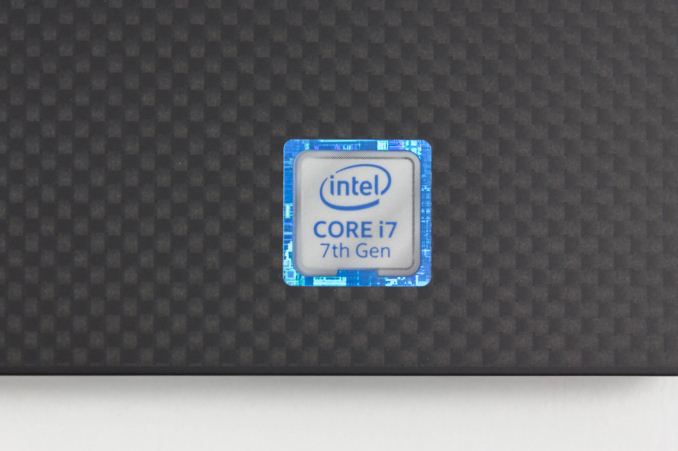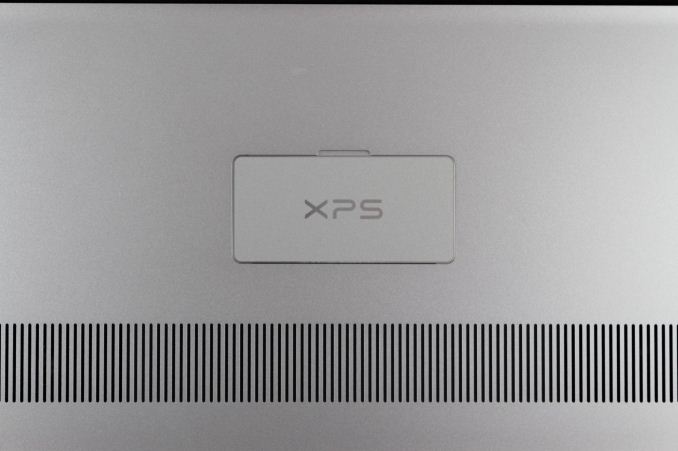The Dell XPS 15 9560 Review: Infinity Edge Part Two
by Brett Howse on July 31, 2017 8:00 AM EST
Near the end of 2015, Dell rolled out their new XPS styling cues, that were so successful on the XPS 13, to its larger sibling, the XPS 15. Thanks to the Infinity Edge display, Dell’s new XPS 15 packed a full 15.6-inch display into a notebook closer to the size of a 14-inch model. Perhaps the size reduction is not quite as dramatic as the XPS 13 when it first launched with the thin-bezel design, but Dell also kept the performance heart of the XPS 15 intact with the change, keeping a quad-core 45-Watt CPU, and NVIDIA GTX 960M graphics.
Dell has since done a revision from that XPS 15 9550 model to the latest 9560 version. The small model number change might signify that this is a small revision. On the exterior that is certainly the case, with the overall XPS 15 design remaining relatively unchanged, but under the hood there are some more impressive changes awaiting.
The first is a move to Intel’s 7th generation Core processors. Although performance per clock did not change from 6th to 7th generation, a new, improved, 14nm process does allow higher frequencies without blowing through the thermal design power restraints. This allows a small boost in performance over the same designation CPU from the previous design.
More importantly, NVIDIA announced newer graphics to replace the outgoing Maxwell based GTX 960M. The Pascal based GTX 1050 is a significant upgrade, dropping the M branding. Pascal offers much more compute, thanks to the new architecture based on 14nm FinFET, and the GDDR5 capacity doubles from the 2 GB on the GTX 960M to 4 GB on the GTX 1050. The XPS 15 was never a gaming laptop, but a much more capable graphics card certainly helps propel it closer to those dedicated machines, and also can play a big role in compute tasks that can leverage the GPU.
| Dell XPS 15 9560 Configurations | |||
| Core i3 | Core i5 | Core i7 (Model Tested) |
|
| GPU | Intel HD 630 | Intel HD 630 + NVIDIA GeForce GTX 1050 w/4GB GDDR5 |
|
| CPU | Intel Core i3-7100H (35w) Dual-Core w/HyperThreading 3.0 GHz |
Intel Core i5-7300HQ (45w) Quad-Core 2.5-3.5 GHz |
Intel Core i7-7700HQ (45w) Quad-Core w/HyperThreading 2.8-3.8 GHz |
| Memory | 8-32GB DDR4-2400 RAM Two SODIMM slots, 32GB Max |
||
| Display | 15.6" IPS 1920x1080 sRGB | 15.6" IPS 1920x1080 sRGB Optional 3840x2160 IGZO IPS w/Adobe RGB color space and touch |
|
| Storage | 500GB 7200 RPM Hybrid w/32GB NAND | 1TB 5400 RPM Hybrid w/32GB NAND | 256/512/1024 GB PCIe NVMe SSD |
| Networking | Killer 1535 Wireless-AC 2x2 + Bluetooth 4.1 Optional Intel 8265 Wireless-AC 2x2 + Bluetooth 4.1 |
||
| I/O | USB 3.0 x 2 w/Powershare SD Card reader 1 x USB 3.1 Gen 2 Type-C w/Thunderbolt 3 (2 lanes PCIe) Headset Jack HDMI 1.4 |
||
| Dimensions | (mm) : 357 x 235 x 11-17 (inches) : 14.06 x 9.27 x 0.45-0.66 |
||
| Weight | With 56 Wh Battery 1.8 kg / 4.0 lbs With 97 Wh Battery 2 kg / 4.5 lbs |
||
| Battery | 56 Wh | 56/97 Wh | |
| Price | $999+ As tested: (Core i7-7700HQ, 3840x2160, 512 GB, 16GB) $1850 |
||
Dell didn’t stop there. The previous model offered either a 56 Wh battery, or a stout 84 Wh version. With the latest 9560 version of the XPS 15, that larger battery is bigger again, boasting a 97 Wh capacity, which is right near the 99 Wh limit allowed in a notebook. Dell claims the 9560 is the class leader in battery life for a 15.6-inch notebook, at least when doing productivity tasks, with up to 19.5 hours of battery life.
The battery life will be impacted significantly by the choice of displays though, and just like the 9550 model, Dell is offering both a 1920x1080 (FHD) non-touch version, as well as a 3840x2160 (UHD) panel with touch. The higher resolution also targets 100% of the Adobe RGB color gamut. With both a higher resolution, and wider color gamut, the UHD version is not the one to get if you need the longest battery life, but may be the optimal version if Adobe RGB is important for your workflow.
Not all of the changes are for the best though. Dell has dropped the 3x3:3 Broadcom wireless option for the 9560, which is a shame since Dell was one of the few PC suppliers to offer a 3x3:3 solution. They’ve opted to go with the same Killer Wireless-AC 1535 as they use in the smaller XPS 13. This is a 2x2:2 solution, which is definitely going to impact transfer speeds.
There’s also lots of connectivity options, with Dell supporting HDMI 1.4, USB 3.0 with PowerShare, a SD card reader, and a USB-C port supporting Thunderbolt 3. The last port allows for a single cable docking solution, which can drive up to two UHD displays, as well as charge the laptop.
The inside has changed a lot, but the outside has stayed mostly the same. That’s not a bad thing either, since the XPS 15 was already one of the sleekest looking large display productivity notebooks around.












82 Comments
View All Comments
aznchum - Tuesday, August 1, 2017 - link
I was in this same pickle for the XPS 15 9550 when it first came out in Nov 2015. Issues with lag on waking from sleep and screen flickering. Had to disable the HD 630 graphics to remove the lag waking from sleep and the screen flickering, but that totally kills your battery running the GTX 960M all the time. This may have been fixed with drivers given Skylake was brand-spanking-new at the time. I ponied up the extra money and got the Mid 2015 15" rMBP. Never looked back and never had an issue. If you MUST have windows, use Parallels.nagi603 - Monday, July 31, 2017 - link
A colleague of mine had a faulty keyboard. The right ctrl button got stuck. Factory new, etc... Looks like QC is not the best at Dell.Garrett S. - Monday, July 31, 2017 - link
Laxaa,Check my amazon verified purchase reviews of the Dell XPS 15 9560. I've had 3 different laptops. All 3 have the infamous screen flashing/screen strobing, which occurs randomly, sporadically, at different time frames.
2 laptops were brand new from dell, factory sealed, from Amazon with 4k screen options, and both of the screens were like bloody strobe lights at a dance club. Also had half (left side only) audio coming out of headphone jack on 3 different headphones. I've had bad screens on all 3, defective headphone jacks, and once, on a brand new one, the fn key was bent in the air (again, check the photos).
So I tried a manufacturer refurbished directly from dell, and walla! Same good ole dancing strobe light (but didn't occur as often as the brand new ones did... it took about 2 hours of usage before screen started rapidly flashing like a strobe, which actually induces seizures).
I left reviews on Amazon (video/photo evidence), and mine are verified purchases (which means my reviews are not fake and/or fraudulent).
I'm going to purchase brand new laptop number 4 tomorrow, and most likely later on, number 5, 6, etc...
Dell: Don't worry guys. I'll cycle through hundreds and hundreds of your laptops until I find a working laptop!! I'll help the shipping company with weekly deliveries until you get your act together. For now, I'm writing this on my 2013 Macbook Pro retina, arguably, the world's greatest laptop ever created.
Laxaa - Tuesday, August 1, 2017 - link
I guess ease of mind is what's going to justify spending extra on the MacBook Pro, because that doesn't sound good at all. And I've read similar things on Reddit as well.mr_tawan - Monday, July 31, 2017 - link
It would be great if they include the numeric pad on the keyboard.DanNeely - Monday, July 31, 2017 - link
They can't. Not enough room without using undersize keys for the entire keyboard. Slim bezels mean its about an inch narrower than a traditional fat bezel 15.6" laptop, roughly the size of a 14" fat bezel model which is also too narrow to fit a numpad.If you want slim bezels and a numpad, you'll need to hope someone makes a slim bezel 17" model. Being the size of a 15" fat bezel laptop, it'll again be wide enough to fit one.
tipoo - Monday, July 31, 2017 - link
I actually feel the opposite, I'd rather a centered keyboard and trackpad than a numpad. If you do data entry there's always external numpads. Most people don't use them that much and the keys are redundant.twtech - Tuesday, August 1, 2017 - link
I'm really glad it doesn't have a numeric keypad. That's the #1 thing I look to avoid when comparing models, and it pretty much rules out everything over 15".I'm actually pretty proficient at using a number pad, but when I have it I use it so rarely, it's not worth having the main part of the keyboard be off-center. I actually don't even use a number pad on my desktop computers either - it's a waste of space.
mr_tawan - Wednesday, August 2, 2017 - link
I agreed that it's not for everyone. For English-only usage it's fine not having a numeric pad. In my case, I also use Thai as well. Thai layout covers the whole main keyboard with no room for numbers (as it contains its own set of numeric characters as well). The only other way to input (Arabic) number is to switch the layout back to English, which is a little bit cumbersome.Anyway thanks for all input (@tipoo, @twtech, andDanNeely). Appreciated.
Glock24 - Wednesday, August 2, 2017 - link
Totally agree. I can't stand the keyboard being off center because of the num pad, and even worse, some laptops have Frankenstein key shapes, sizes and layouts to make the num pad fit.